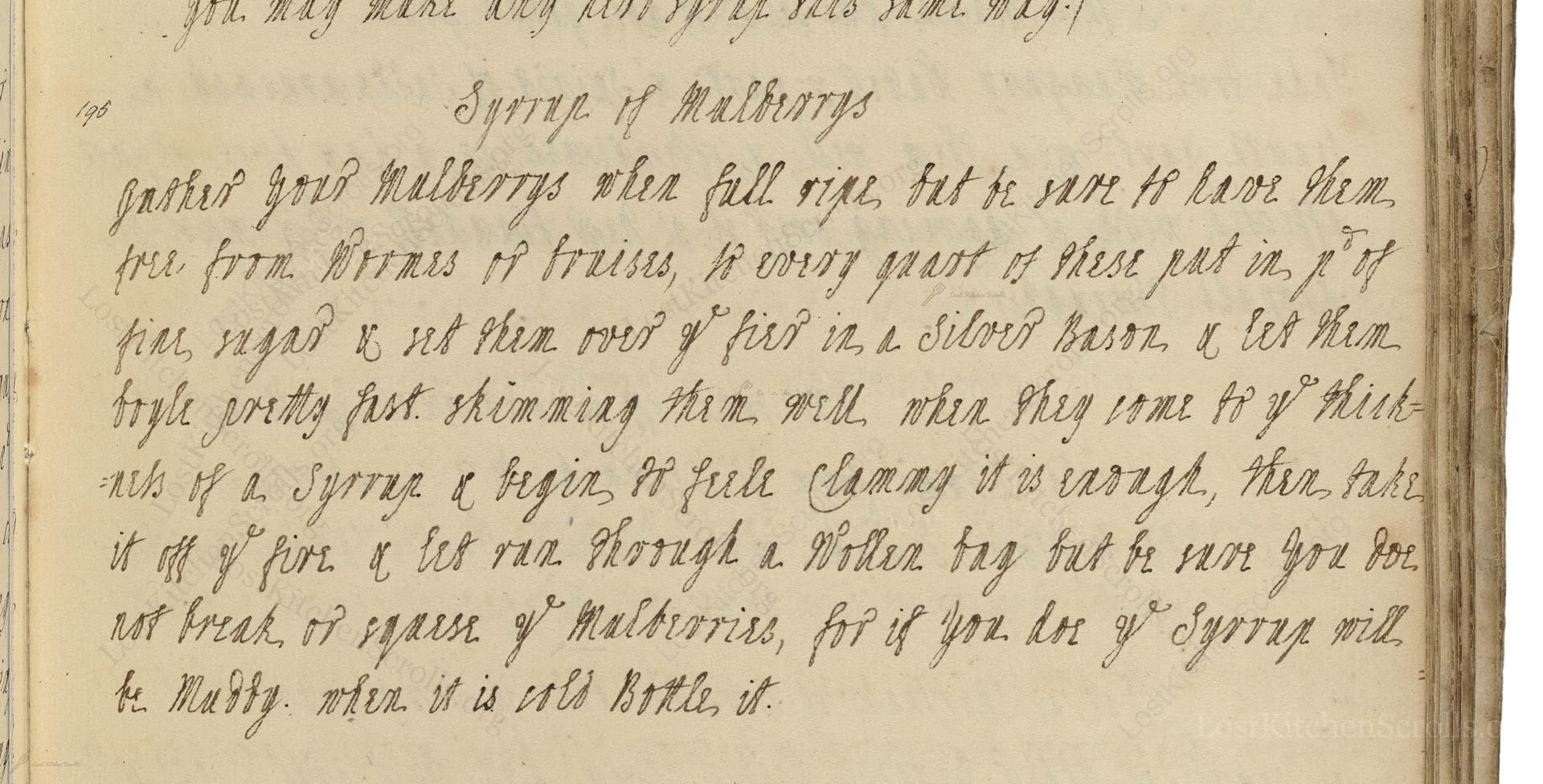
Syrup Of Mulberys
"gather your Mulberrys when full ripe, but be sure to have them free from Worms or bruises, to every quart of these put in pt of fine sugar & set them over ye fire in a Silver bason. & let them boyle pretty fast skimming them well. when they come to ye thickness of a Syrrup & begin to feel clammy it is enough, then take it off ye fire & let run thorough a Wollen bag but be sure you doe not break or squeese ye Mulberrys, for if you doe ye Syrrup will be Muddy. when it is cold Bottle it."
Note on the Original Text
This recipe, like many from the 18th century, is written in an instructive, narrative form without formal ingredient lists or precise measures. Quantities are proportional ('to every quart... a pint of sugar') and the instructions depend on the cook's judgment ('when they... begin to feel clammy it is enough'). Original spelling and abbreviations ('ye' for 'the', 'boyle' for 'boil', 'Syrrup' for 'syrup') are typical of English at the time. Clarifying these for modern cooks aids accessibility, while the practical hands-on wisdom remains unaltered.

Title
Cookery and medicinal recipes of Dorothy Pennyman (1730)
You can also click the book image above to peruse the original tome
Writer
Dorothy Pennyman
Era
1730
Publisher
Unknown
Background
A delightful glimpse into early Georgian kitchens, this culinary manuscript compiled by Dorothy Pennyman showcases the elegant tastes and recipes of 18th-century England—perfect for those hungry for a taste of history.
Kindly made available by
Folger Shakespeare Library
This recipe, compiled by Dorothy Pennyman around 1730, reflects the English domestic tradition of preserving the fleeting bounty of summer fruits. Mulberries, once common in grand English gardens, produced a perishable crop ideal for preserves and syrups. Such recipes were carefully recorded by women like Pennyman, who managed household provisions and produced medicinal and culinary preserves. The syrup would have been used both as a cordial and a medicinal tonic, believed to soothe sore throats or mix with water for a refreshing drink.

Historically, this syrup was cooked over an open hearth using a silver basin (a shallow, wide silver pan prized for its non-reactive properties). Skimming spoons, wooden stirring paddles, and woollen bags (like a jelly bag) were employed for refining the syrup. Bottles were sometimes stoppered with cork and sealed with wax for storage. Today, a heavy stainless steel saucepan, regular kitchen skimmers or spoons, and a fine sieve or muslin cloth replace these specialised tools.
Prep Time
15 mins
Cook Time
30 mins
Servings
10
We've done our best to adapt this historical recipe for modern kitchens, but some details may still need refinement. We warmly welcome feedback from fellow cooks and culinary historians — your insights support the entire community!
Ingredients
- 1 quart (about 4 cups) fresh, fully ripe mulberries (or frozen, thawed mulberries if fresh are unavailable)
- 1 pound (about 2 1/4 cups) fine white sugar (caster sugar is ideal)
Instructions
- Begin by gathering fresh, ripe mulberries—ensure they are free from damage or insects.
- For every quart (about 4 cups) of mulberries, weigh out 1 pound (about 2 1/4 cups) of fine white sugar.
- Place the berries and sugar together in a large, heavy-bottomed saucepan (a stainless steel or non-reactive pot mimics the 'silver bason').
- Bring the mixture to a boil over medium-high heat, stirring gently and regularly skimming off any foam that rises.
- Continue to boil briskly until the mixture thickens and becomes syrupy—check that it feels a little sticky between your fingers, just starting to become 'clammy.' Once ready, remove from the heat and strain the hot syrup through a jelly bag, muslin, or fine clean cloth set over a bowl.
- Do not squeeze or press the mulberries, as this will cloud the syrup.
- Allow to cool, then pour into sterilised bottles.
- Seal, label, and store in a cool place.
Estimated Calories
120 per serving
Cooking Estimates
It takes about 15 minutes to prepare the mulberries and sugar, and around 30 minutes to cook the mixture until it reaches the right syrupy texture. This recipe makes about 750 ml (about 3 cups) of syrup, which is enough for 10 servings. Each serving has about 120 calories.
As noted above, we have made our best effort to translate and adapt this historical recipe for modern kitchens, taking into account ingredients nowadays, cooking techniques, measurements, and so on. However, historical recipes often contain assumptions that require interpretation.
We'd love for anyone to help improve these adaptations. Community contributions are highly welcome. If you have suggestions, corrections, or cooking tips based on your experience with this recipe, please share them below.
Join the Discussion
Rate This Recipe
Dietary Preference
Main Ingredients
Culinary Technique

Den Bockfisch In Einer Fleisch Suppen Zu Kochen
This recipe hails from a German manuscript cookbook compiled in 1696, a time whe...

Die Grieß Nudlen Zumachen
This recipe comes from a rather mysterious manuscript cookbook, penned anonymous...

Ein Boudain
This recipe comes from an anonymous German-language manuscript cookbook from 169...

Ein Gesaltzen Citroni
This recipe, dating from 1696, comes from an extensive anonymous German cookbook...
Browse our complete collection of time-honored recipes



